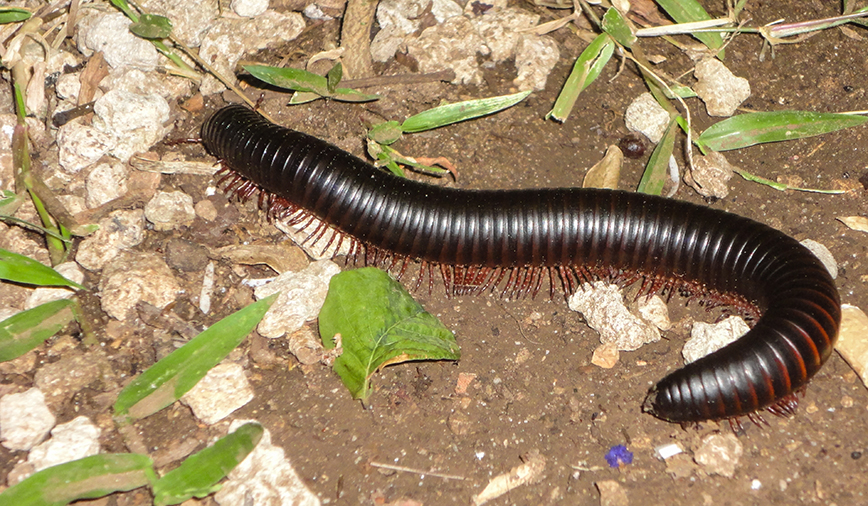May 16, 2014
Millipede
“What the…?!”
If I had a dime for every time I’ve uttered that phrase in wonder at some “new” creature or feature of nature… Well, let’s just say I’d have a lot of dimes.
Better still, thanks to a critter that crossed my path earlier this week, I’d be 10 cents richer even as I write this.
So there I was on Monday, walking the paved road at Johnson’s Mound Forest Preserve in Elburn, when the biggest millipede I’ve ever seen in Illinois came shuffling out of the leaf litter and onto the pavement right in front of me.
My dog Joey, ever-faithful walking companion that he is, stopped short just as I did, and we both stared in amazement at the beauteous beastie that, I kid you not, had to be at least 4 in. in length. That’s an astounding four times as long as the “usual” millipedes we’re accustomed to seeing under logs outdoors and every manner of locations indoors—basements, crawl spaces and garages (and, for some reason, just about every space we have here at Hickory Knolls).
The Johnson’s Mound Millipede, as I now refer to it, was enormous in comparison. In fact, it made me think of some of the wild and wonderful—and huge—millipedes I’ve encountered on misty trails in the Smoky Mountains.
I snapped a few pics of this new item of intrigue and contemplated ending the hike there and then, so I could rush home and sort through possible identifications. Joey, thankfully, felt otherwise, so once we made sure the Millipede (its great size certainly merits use of a capital M) was safely off the road we continued on our walk up the Mound (its great glacial and cultural history is also capital-worthy) and then down before heading back to the car.
Life and schedules being what they are, a few days passed before I was able to really dig in and start the i.d. process. Coffee in hand, I settled in for what I’d imagined would be a long progression of web sites and reference materials. Because millipedes are members of the subphylum Myriapoda, or “many legs,” I felt certain there would be myriad details to sort through.
Boy, was I wrong.
Two clicks into BugGuide.net, my favorite on-line field guide, and I had an answer. The individual belongs to a group of millipedes known collectively as the Narceus americanus/annularis complex.
To my dismay this name didn’t roll off the tongue quite the way Johnson’s Mound Millipede did. But the derivation of the genus name more than made up for it. Narceus, I learned, is a Latinized form of the Greek root narca or narce, which means stupor. It refers to the motionless, or stupor-like, coiled position millipedes assume when disturbed.
A little more digging led me to a few of other common names, the worm millipede, iron worm, and the one I felt most fitting, American giant millipede.
This research also helped quell a nagging fear that I’d harbored ever since running into the little big guy. Since the only other experience I’ve had with large millipedes involved species from other continents, I was afraid the Johnson’s Mound Millipede was nonnative and possibly invasive.
Happily, the Narceus americanus/annularis complex (the “complex” refers to the fact that while 14 species have been described, most have been incorporated into a single, wide-ranging group) is native to the eastern United States, as well as a handful of states just west of the Mississippi.
As millipedes tend to be, this species is relatively inoffensive, quietly going about its business on moist woodland floors scavenging amongst the fallen leaves and mosses. Amazingly, those many legs never trip up or tangle but instead move in a wave-like motion either forwards or—and this is neat when you think about it—backwards, depending on terrain and/or obstacles.
Young millipedes hatch from eggs laid in moist soil and spend two to three years feeding and molting, adding body segments and pairs of legs as they grow. The oldest American giant millipede on record lived an impressive 11 years.
If you should be lucky enough to encounter one of these creatures, try to resist the urge to pick it up. While millipedes lack the fangs and venom of their cousins, the centipedes, they do pack a powerful chemical punch in the form of benzoquinones –compounds that can be irritating to the eyes and skin—released through small openings called ozopores when the animal is agitated.
In addition, if you do indeed discover a giant American millipede—at Johnson’s Mound or elsewhere–I’d love to hear about it. Just a quick phone call or email with the date and location of your find would be fine.
I’ll be sure to richly reward you, not only with profuse words of thanks but also–if you want–a shiny new dime.
Pam Otto is the manager of nature programs and interpretive services at the Hickory Knolls Discovery Center, a facility of the St. Charles Park District. She can be reached at 630-513-4346 or potto@stcparks.org

